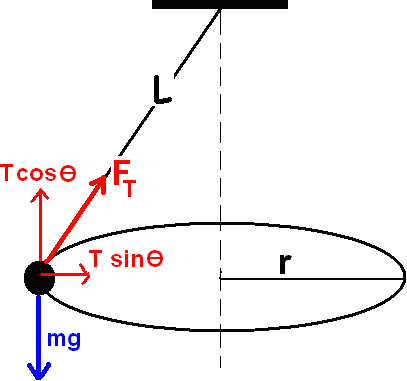Help please?!
3 Answers
See below.
Explanation:
The equilibrium before the string break is attained at radius of rotation regarding the vertical of
with
We know that considering the momenta regarding
Considering the movement referential at the bob, after the break the movement equations are
and the flying distance ground projected is
Given that
-
the length of the string in the conical pendulum
#color(blue)(l=1.5m)# -
the mass of the bob
#color(blue)(m=2.5kg)# -
the angle of inclination of the string during uniform circular motion of the bob is
#color(blue)(theta=53^@)# -
the height of point of suspension (
#A# ) of the bob#color(blue)(AC=3m)# -
the radius of horizontal circular path
#color(blue)(r=lsintheta=1.5sin53^@=1.5xx0.8=1.2m)# -
#T# be the tension on the string
and
#v# be the uniform speed of the bob.
Here the bob will be in a dynamic equilibrium.
- Horizontal component of the tension provides the the centripetal force required for uniform circular motion with
speed
Hence
#(mv^2)/r=Tsintheta....[1]#
- The vertical component of the tension T will balance the weight of the bob
Hence
#mg=Tcostheta.....[2]#
Now dividing [1] by [2] we get
#v^2/(rg)=sintheta/costheta#
-
(i) So the tangential speed of the bob at the time of breaking of string is
#color(red)(v=4m"/"s)# -
Now the height of the horizontal circular path from the ground
#h=AC-lcostheta#
If
Hence
(ii) So the required time
If
(iii) If the distance of the bob on the ground from the rod be
(i)

The problem is depicted as a conical pendulum in the figure above.
#Tcostheta=mg# ......(1)
The horizontal component provides the necessary centripetal force.
#Tsin theta=(mv^2)/r# .....(2)
where#v# is the constant velocity of the bob.
From the figure Radius
#r=Lsintheta=1.5xxsin53^@#
Dividing (2) with (1)
#sintheta/costheta=v^2/(rg)#
Substituting value of
(ii) Given is height of point of suspension
Height of the bob from the ground
After breaking of string the bob has only one force acting on it. It falls freely under gravity. Noting that initial downward velocity
#h=ut+1/2 g t^2#
Inserting various values we get
#2.1=0xxxxt+1/2xxgxxt^2#
#=>t^2=2.1xx2/9.81#
#=>t=0.65s# , rounded to two decimal places
(iii) Horizontal distance of the bob on the ground from the rod is due to horizontal tangential velocity at the time of breaking of the string.
Horizontal Distance covered in
Total distance on the ground from the rod


